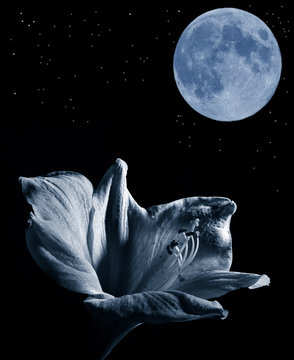Introduction:
In the ethereal realm of nature’s wonders, there exists a mesmerizing flower that encapsulates the allure and mystery of the night sky – the Moon Lily. This celestial blossom, scientifically known as “Hymenocallis,” captivates with its delicate, moonlit appearance and unique characteristics. In this article, we will delve into the enchanting world of Moon Lilies, exploring their origin, symbolism, cultivation, and cultural significance.
Origin and Characteristics:
Moon Lilies are perennial flowers native to the tropical and subtropical regions of the Americas, particularly the southeastern United States, Mexico, and Central America. They belong to the Amaryllidaceae family and share their botanical heritage with amaryllis and daffodils.
What sets Moon Lilies apart is their extraordinary appearance. With pure white, trumpet-shaped flowers resembling the moon’s gentle glow, they bloom during the twilight hours, releasing a subtle fragrance that permeates the night air. Their long, slender, and greenish-white leaves further contribute to their mystical aura.
Symbolism and Cultural Significance:
Throughout history, Moon Lilies have been celebrated in various cultures, each attributing different meanings and symbolism to these captivating flowers. Some of the common symbolisms associated with Moon Lilies include:
a) Moonlit Beauty: The Moon Lily’s resemblance to the moon, combined with its nocturnal blooming, signifies the serenity and beauty of the night. In many cultures, it is seen as a symbol of tranquility and inner peace.
b) Love and Devotion: Moon Lilies are often associated with themes of love, purity, and devotion. In ancient times, lovers would gift these flowers to express their profound affection and commitment to one another.
c) Spiritual Enlightenment: In some spiritual contexts, the Moon Lily represents the journey towards spiritual enlightenment and the pursuit of higher consciousness.
Moon Lily Cultivation:
Though Moon Lilies thrive in their natural habitat, they can be cultivated in various regions with proper care and attention. Here are some essential tips for successful Moon Lily cultivation:
a) Sunlight: Moon Lilies prefer partial to full sunlight. Plant them in an area that receives at least 4-6 hours of sunlight daily.
b) Soil and Watering: Well-draining soil is crucial to prevent waterlogging. Water the plants regularly, but avoid overwatering as it may cause the bulbs to rot.
c) Temperature and Climate: These flowers prefer warm temperatures and do best in USDA hardiness zones 8 to 10.
d) Propagation: Moon Lilies can be propagated through their bulbs. After the blooming season, allow the foliage to wither naturally before dividing and replanting the bulbs.
Preserving Moon Lilies in the Wild:
Despite their enchanting allure, Moon Lilies face threats in their natural habitats due to deforestation, urbanization, and climate change. Conserving these delicate flowers is essential to preserve the biodiversity of our planet. Governments, conservationists, and nature enthusiasts must work together to protect the ecosystems where Moon Lilies thrive.
Get More Information About Moon Lily On Hint



